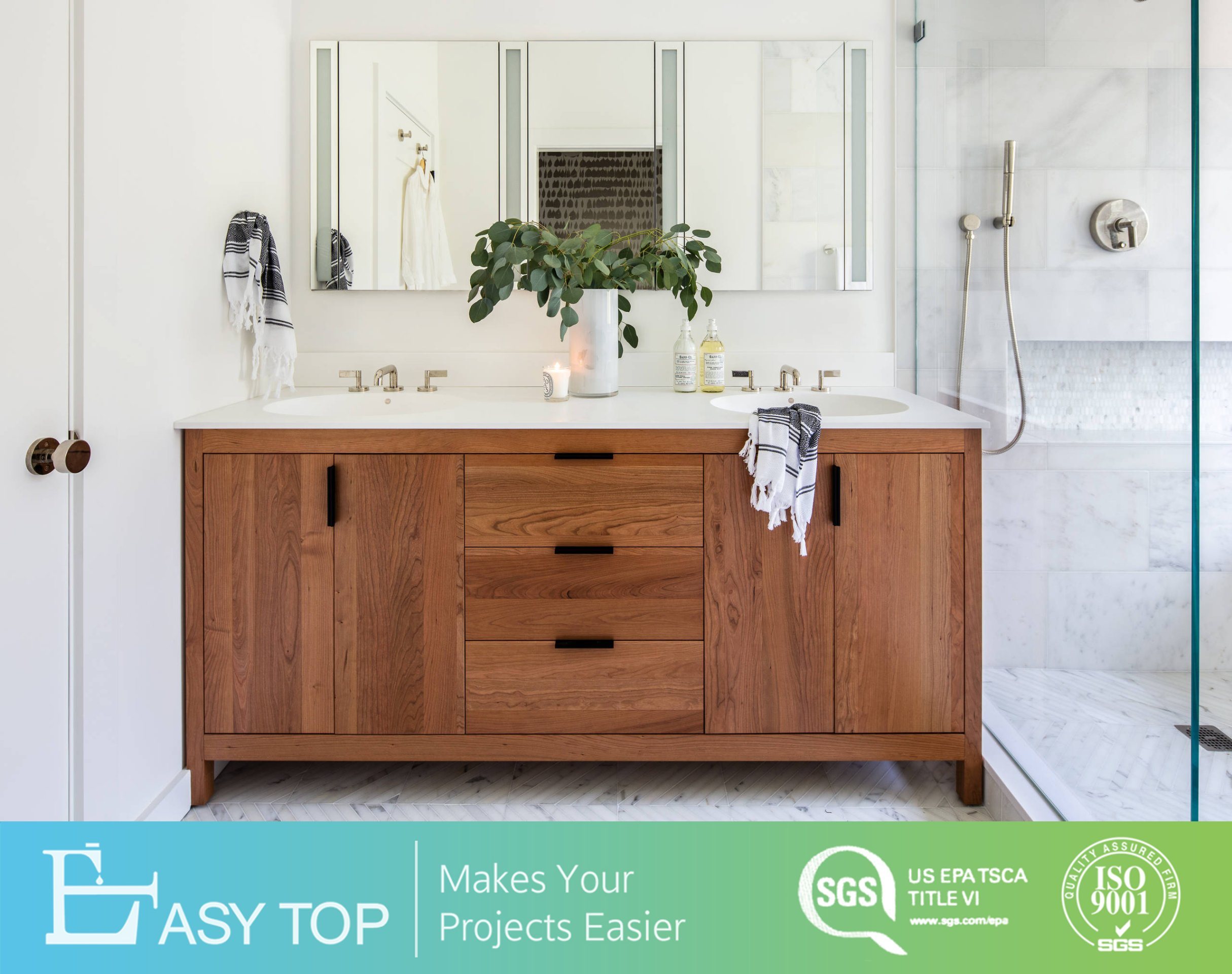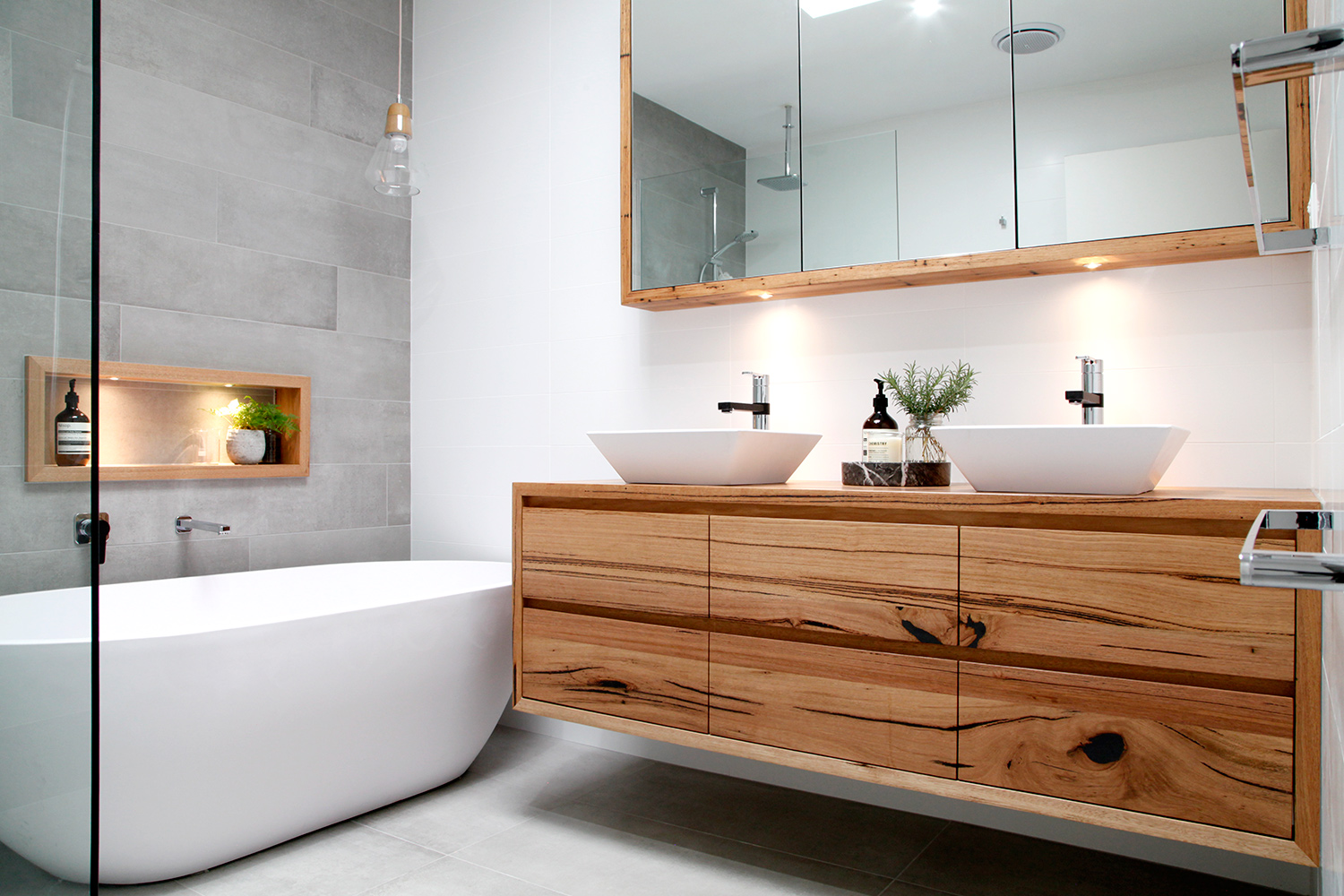The Appeal of Modern Timber Bathroom Vanities: Modern Timber Bathroom Vanity

Modern bathroom design is embracing a shift towards natural materials, with timber taking center stage. Timber vanities are becoming increasingly popular, adding a touch of warmth, sophistication, and sustainability to contemporary bathrooms.
The Warmth and Sophistication of Timber Vanities
Timber vanities bring a sense of warmth and natural beauty to bathrooms, creating a calming and inviting ambiance. The rich grain patterns and textures of wood add visual interest and depth, complementing a wide range of design styles, from minimalist to traditional. Timber’s inherent warmth contrasts beautifully with cool, modern fixtures, creating a balanced and sophisticated aesthetic.
Sustainability and Durability of Timber Vanities
Timber is a renewable resource, making it a sustainable choice for bathroom furniture. Unlike synthetic materials, timber vanities can be sourced from responsibly managed forests, contributing to environmental conservation. Moreover, timber is known for its durability and longevity, making it a wise investment that will stand the test of time.
Popular Timber Species for Bathroom Vanities
A wide array of timber species is suitable for bathroom vanities, each offering unique characteristics and aesthetics.
Commonly Used Timber Species
- Oak: Oak is a durable and water-resistant hardwood known for its distinctive grain patterns and warm tones. Its strength and resilience make it an excellent choice for high-traffic areas like bathrooms.
- Walnut: Walnut is a luxurious hardwood prized for its rich, dark color and intricate grain patterns. It adds a touch of elegance and sophistication to bathroom vanities, creating a timeless and sophisticated aesthetic.
- Cherry: Cherry is a hardwood with a beautiful reddish-brown hue that deepens with age. It is known for its smooth texture and subtle grain patterns, adding a touch of warmth and sophistication to bathroom vanities.
- Maple: Maple is a durable hardwood with a pale, creamy color and fine grain patterns. It is often used for bathroom vanities in contemporary designs, offering a clean and minimalist aesthetic.
- Teak: Teak is a tropical hardwood known for its exceptional durability, water resistance, and natural oils that repel insects and moisture. It is often used for outdoor furniture but is also suitable for bathroom vanities, adding a touch of exotic elegance.
Design Considerations for Modern Timber Bathroom Vanities
A modern timber bathroom vanity is a statement piece, adding warmth and character to your bathroom. Choosing the right design for your vanity is crucial, as it should complement the overall style of your bathroom and meet your practical needs.
Design Styles
The design of your timber bathroom vanity should align with the overall style of your bathroom. Here are some popular styles that complement modern timber vanities:
- Minimalist: Characterized by clean lines, simple forms, and a focus on functionality. Minimalist vanities often feature a sleek, uncluttered design with a focus on natural wood finishes. An example is a vanity with a simple rectangular countertop and a single, integrated sink.
- Scandinavian: Known for its simplicity, functionality, and natural materials. Scandinavian vanities often feature light wood finishes, such as birch or pine, and minimalist hardware. A Scandinavian-style vanity might have a simple, rectangular form with open shelving and a focus on natural light.
- Industrial: A blend of rustic and modern elements. Industrial vanities often feature reclaimed wood, metal accents, and exposed plumbing. An example is a vanity with a distressed wood finish, metal legs, and industrial-style hardware.
- Contemporary: Embraces modern design elements, often featuring bold lines, geometric shapes, and a focus on functionality. A contemporary vanity might have a sleek, minimalist design with a focus on clean lines and geometric shapes.
Finishes and Treatments
The finish and treatment of your timber vanity will impact its overall look and feel. Here are some popular options:
- Natural Wood: Offers a warm, natural aesthetic. The natural grain and texture of the wood are showcased, adding character and warmth to the bathroom.
- Stained: Enhances the natural beauty of the wood by adding color and depth. Stains can be used to create a variety of looks, from light and airy to rich and dramatic.
- Painted: Offers a clean, modern look. Painted vanities can be customized to match the color scheme of your bathroom.
- Distressed: Adds a touch of rustic charm. Distressed finishes are achieved by using techniques such as sanding, scraping, and distressing to create a worn, vintage look.
Storage Solutions
A well-designed timber vanity should offer ample storage space for all your bathroom essentials.
- Drawers: Provide convenient storage for toiletries, towels, and other bathroom items. Drawers can be customized with different sizes and configurations to meet your specific needs.
- Cabinets: Offer more storage space than drawers and can be used to store larger items, such as hair dryers and styling tools. Cabinets can be designed with adjustable shelves to accommodate different items.
- Open Shelving: Adds a touch of style and functionality. Open shelves are great for displaying decorative items or storing frequently used items.
Practical Considerations for Modern Timber Bathroom Vanities

Modern timber bathroom vanities are a beautiful and stylish addition to any bathroom, but they also require some practical considerations to ensure their longevity and performance. Choosing the right timber species, applying appropriate finishes, and understanding the impact of moisture and humidity are crucial factors in maintaining a timber vanity’s beauty and functionality.
Timber Species and Finishes
The durability and water resistance of timber species vary significantly. Some timbers are naturally more resistant to moisture and decay than others, while finishes can enhance their protection.
- Hardwoods: Hardwoods like oak, maple, and cherry are known for their durability and resistance to scratches and dents. They are also naturally resistant to moisture, but require proper finishing to enhance their water resistance.
- Softwoods: Softwoods like pine and cedar are less durable than hardwoods, but they are more affordable and have a softer, more rustic look. They are also more susceptible to moisture damage and require careful sealing.
- Engineered Timber: Engineered timber, such as plywood and MDF, is a good option for bathroom vanities due to its stability and moisture resistance. It is often laminated with a hardwood veneer for a more natural look.
Finishes play a crucial role in protecting timber vanities from water damage. Oil-based finishes, such as polyurethane, provide a durable, water-resistant barrier. Water-based finishes, such as acrylic or latex, are also effective, but may require more frequent reapplication.
Maintaining and Caring for Timber Vanities, Modern timber bathroom vanity
Regular maintenance is essential to ensure the longevity of a timber bathroom vanity.
- Cleaning: Clean your timber vanity regularly with a mild soap and water solution. Avoid harsh chemicals or abrasive cleaners, which can damage the finish.
- Drying: Dry the vanity thoroughly after cleaning, especially around the sink and faucet areas. Excess moisture can lead to warping, cracking, or mildew growth.
- Refinishing: Periodically refinish your timber vanity to maintain its protective layer and enhance its appearance. Follow the manufacturer’s instructions for the specific finish used.
Impact of Moisture and Humidity
Moisture and humidity are major factors that can affect the longevity of timber bathroom vanities.
- Warping and Cracking: Moisture can cause timber to warp and crack, especially if it is not properly sealed. This can occur when the timber absorbs moisture unevenly, causing it to expand and contract.
- Mildew Growth: Humidity can create a favorable environment for mildew growth, which can damage the timber and its finish.
- Rot and Decay: Excessive moisture can lead to rot and decay, especially in softwoods.
Preventing Damage from Moisture and Humidity
Several measures can be taken to prevent moisture and humidity damage to timber bathroom vanities.
- Proper Ventilation: Ensure adequate ventilation in the bathroom to reduce humidity levels. This can be achieved through exhaust fans, windows, or other ventilation systems.
- Moisture-Resistant Materials: Use moisture-resistant materials for countertops and backsplashes, such as granite, quartz, or ceramic tile.
- Water-Resistant Sealants: Apply a water-resistant sealant to the timber vanity, especially around the sink and faucet areas.
- Regular Maintenance: Regularly clean and dry the vanity to prevent moisture buildup.
A modern timber bathroom vanity is totally rad, especially if you’re going for that sleek, minimalist vibe. You can totally rock it with a sage color bathroom rug, like these awesome ones , to bring some chill vibes to the space.
And if you want to make it even more lit, add some cool plants and some trendy wall art!
Yo, a modern timber bathroom vanity is totally the bomb, right? But let’s be real, keeping your bathroom fresh is key. If you’ve got bathroom rugs with rubber backing, check out how to wash bathroom rugs with rubber backing so they stay clean and don’t get all gross.
Once your bathroom is looking good, a modern timber vanity will really make it pop!

